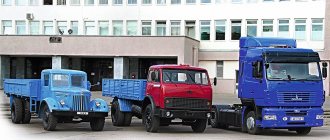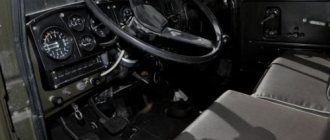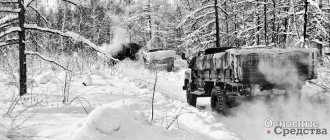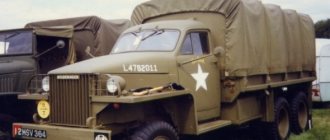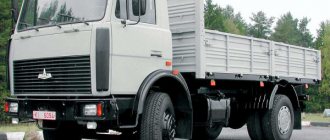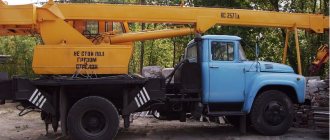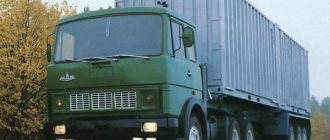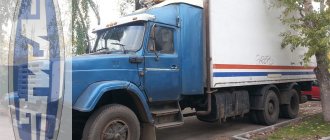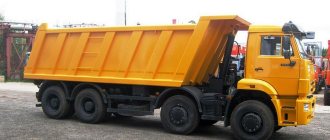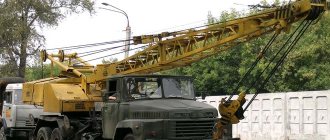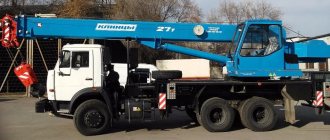History of creation
The development of a new army all-terrain vehicle, designed for transporting military equipment and mounting missile weapons, began at the MAZ plant in the late 50s. The design of the vehicle was based on components of the already produced MAZ-537. Thanks to this, the creation of the truck was completed in 1962. The new all-terrain vehicle, designated MAZ-543, was presented to the public in 1965 during a parade dedicated to the anniversary of the October Revolution. The vehicles shown were equipped with a launcher for the 9K72 Elbrus missile.
Nine years later, a civilian onboard version of the vehicle was presented at VDNKh. The equipment was distinguished by a simplified design, in which there was no special army equipment. Deliveries began 2 years later, but the all-terrain vehicle was not widely used in motor vehicles. The bulk of the vehicles produced were supplied to the construction of oil and gas pipelines in Siberia. The equipment was also used as a special airfield fire truck and as a ballast tractor.
An unexpected decision regarding the choice of cabin layout for the MAZ-543
The new missile system, called Temp-s, had a very long missile (12,380 mm), so the chassis length was clearly not enough. It was decided to make a special recess in the middle of the cabin, but this could not be implemented. Since all that remained was to lengthen the frame, chief designer Shaposhnikov made a very bold and extraordinary decision - to divide the large cabin into two isolated ones, between which the head of the rocket was located.
Although there were immediately many skeptics who argued that it was unacceptable to use a material resembling plastic for the cabin, tests of the cabin proved the opposite. During testing under shock load, the test stand collapsed, but the cabin itself survived.
Mounted armor plates were developed specifically for the cabin. Since the MAZ-543 had to fit into the railway format, the cabins received 2 seats each, and the seats were not located in a row, but one after another.
Specifications
The car is based on a frame made from riveted and welded elements. The side spars are equipped with internal reinforcing linings. The elements are located along the top and bottom edges along the entire length. The front part of the frame is equipped with a bumper and a towing device; at the rear, towing eyes are installed on the side surface of the side members.
The power plant is a V-shaped 12-cylinder diesel engine D-12A-525A.
The motor is equipped with an atmospheric pressure air supply system and a mechanical plunger pump. The power unit develops a maximum power of 525 hp. at 1400 rpm. An overdrive gear is connected to the engine, the torque from which is supplied to a hydraulic 1-stage transformer.
Paired with a transformer is a planetary 3-speed gearbox. Power distribution across the axles is carried out using a mechanical transfer gearbox. The design of the unit has 2 speeds and an additional center differential with the ability to lock. Each axle has a wheel drive and an additional planetary gearbox in the hub. The transmission of torque between the units is carried out by cardan shafts.
The all-terrain vehicle is equipped with an individual torsion bar suspension for each wheel. The design has additional levers that ensure wheel movement in the vertical plane and fixation in the horizontal plane. To reduce the rigidity of the unit, a hydraulic shock absorber is used. The steering wheels are equipped with a steering knuckle with a constant velocity joint.
Dimensions and technical characteristics of the vehicle as standard:
- length - 11657 mm;
- width - 2975 mm;
- front and rear bogie base - 2200 mm;
- the distance between the internal axes of the bogies is 3300 mm;
- height - 2950 mm;
- ground clearance - 400 mm;
- load capacity - 20,000 kg;
- curb weight - 23,000 kg;
- trailer weight - 25000 kg;
- highway speed - 60 km/h;
- fuel reserve - 520 liters in the main tanks and 180 liters in the reserve tank;
- fuel consumption - 125 liters per 100 km (on the highway);
- the length of the road train with trailer MAZ-8385 is 20500 mm.
The all-terrain vehicle has 2 cabins, between which there is an engine compartment. Each cabin is designed for 2 people, there are 2 doors in the side panels. Windshields are rigidly fixed in the openings and equipped with wipers. To heat the cabins, individual radiators are installed, connected to the engine cooling system. Air circulation through the honeycombs is carried out using electric fans.
The left side cabin is equipped with a steering column, a gear shift lever and other controls. The steering is equipped with a hydraulic booster for each of the 2 axles. When turning, the wheels on the 1st and 2nd axles deviate at different angles. The all-terrain vehicle is equipped with pneumatically controlled drum brakes.
Device
The MAZ-6430 is equipped with a modernized air suspension with an automatic control valve, which allows the semi-trailer to be automatically transferred to the transport position after loading and unloading operations. The driver's participation in this process is not required.
Another distinctive feature of the truck was the modified appearance and cabin with new headlights, a 460 mm steering wheel, an upper shelf located under the windshield, improved cladding, an instrument panel, a composite bumper and an interesting instrument panel.
The main goal of refining the MAZ-6430 cabin was to solve a number of technological and operational issues: organizing air flow to reduce pollution and improving aerodynamics. The use of splash guards helped to minimize disruption to other road users in rainy weather.
The drive axles of the MAZ-6430 have a pneumatic 4-bar suspension. Electronic systems and electrical equipment on the tractor have been significantly improved. The main innovation was the appearance of the advanced switching equipment unit "BKA-4" with electrical connectors "Power Timer" and "knife" type fuses. This increased the reliability of the car.
The headlight unit is made in one housing and includes low and high beam elements, a front turn signal, dimensions and a built-in low beam angle corrector. The headlamp is distinguished by increased protection from impacts and a modern design.
The instrument panel has an extensive information area that displays the status of the vehicle's components and systems. It includes a multifunctional monitor that displays data in digital form.
The MAZ-6430 air suspension is equipped with an ECAS control system with a modern set of systems: diagnostic and control functions, load on the drive axles and fuel consumption control. The tractor is also equipped with an advanced anti-lock and traction control system. The latter functions very effectively.
A Stoneridge tachograph, belonging to category MTSO 1324, appeared on the top shelf of the cabin. It is electrically connected to the instrument panel. The cabin also contains a voltage converter, a special socket for charging a phone or connecting a TV, and power windows.
Getting into the MAZ-6430 cabin has become more convenient due to the large doorway and the successful design of handrails and steps. It is already quite difficult to distinguish the cabin of the latest modifications of the model from foreign analogues. It uses modern materials, and the instrument cluster is clearly visible at any time. There is also a small fold-out table on the center console.
Already in the basic version, the MAZ-6430 is equipped with a sprung driver's seat, a spoiler, a tachograph, a speed limiter, seat belts, an engine heater and ABS. An independent air heater installed in the cab and an electronic traction control system (ASR) are optionally available for the tractor.
Modifications
There were a number of modifications based on the 4-axle truck:
- The first prototype of the new civilian vehicle was built with an onboard all-metal platform. Subsequently, similar vehicles were built serially under the designation 7310. The design provided for joint operation with a 2-axle MAZ-8385 trailer.
- For operation as a whip carrier and installation of various equipment, the plant supplied chassis model 73101. Based on the chassis, airfield fire trucks of models AA-60-160 and 160-01, as well as AA-70-220 and APS-70 were built.
- Based on a standard-length chassis, the KS-5573 crane was produced, designed to move a load weighing 25 tons. The equipment was used in the construction of oil pipelines in hard-to-reach areas of Western Siberia.
- The modified chassis with a payload capacity increased by 1000 kg received the MAZ-73131 index. The car has been mass-produced since the beginning of 1983. A flatbed truck with similar design changes was designated MAZ-7313.
- For installation of special equipment, a chassis version was supplied, which was distinguished by shortened frame side members on the rear overhang and a rear bogie base reduced to 1700 mm. At the same time, the distance between the internal axes of the bogies was reduced to 2470 mm. Based on the chassis, the MAZ-7510 dump truck was built in small series, designed to transport 11.5 m³ of soil weighing up to 19,000 kg. The use of a shortened chassis made it possible to reduce the overall length of the vehicle to 10,235 mm.
- Ballast tractor MAZ-73132, built on a shortened version of the vehicle. Used at army airfields to tow aircraft.
- KS-6571 crane units, designed to work with a load weighing 40 tons, were mounted on the modified chassis. The production of the machines was carried out, located in Odessa.
In the gaming and souvenir industry
- A scale model of the MAZ-7310 in four modifications (on-board and fire) is produced in Kazan at NPO Elekon. Scale 1:43. A rather large and heavy model is made of metal and plastic. Flatbed and tank models differ little from each other other than color. The fire model differs from the Aeroflot model in color and the presence of fire equipment.
- A scale model of the BM-30 combat vehicle (9A52-2) of the 9K58 Smerch multiple launch rocket system on the MAZ-543M chassis was produced by GE Fabbri and was published in the magazine series “Russian Tanks” (issue 29, October 2011). Scale 1:72. The model is made of metal and plastic.
- A model for self-assembly of the 9K72 Elbrus OTRK on the MAZ-543 chassis, as well as the 9K58 Smerch MLRS, were produced by Trumpeter. Scale 1:35.
- A model for self-assembly from paper MAZ-7310 in an on-board modification was produced by the publishing house "UT for Skillful Hands". Scale 1:32.
- A model for self-assembly from paper MAZ-7310 in the airfield fireman modification was produced by the Levsha publishing house. Scale 1:30.
- The MAZ-7911 model for self-assembly was produced by Modelcollect. Scale 1:72
- A model for self-assembly of the MAZ-7310 in the airfield fireman modification was produced by A&A Models. Scale 1:72. The set was presented in the standards of the Kyiv Zhulyany Airport, on the wide end of the sidewall cover of 2 Zhulyany, 1 Zhukovsky and 2 Alma-Ata marking schemes.
- A model for self-assembly of the MAZ-7310 in the modification Radar 30N6E1 was produced by PST Models. Scale 1:72.
- A model for self-assembly of the 9K72 Elbrus OTRK on the MAZ-543 chassis was produced by Toxsomodel. Scale 1:72.
- Truckers 2 (game) - the Storm T2310 truck is based on the MAZ-7310.
- In the game, SpinTires are called "Model E-7310".
- In Command & Conquer: Generals, the Scud launcher, the GAO's artillery, is based on the MAZ-7310.
- In the game Operation Flashpoint: Cold War Crisis and ArmA II: Operation Arrowhead in the form of 9K72 "Elbrus"
- In the game Grand Theft Auto Online there is a launch vehicle based on the MAZ-7310.
- In the game Fallout 76 - a fire truck.
Important Characteristics of the MAZ-5336 on-board vehicle and the TOP-4 of its modifications
This is interesting: Troubleshooting and electrical circuit design of a MAZ car: we describe in detail
Features and operation
Being in the cabin of the new MAZ 6430, it is impossible to distinguish it from the world's best analogues. The use of a flat floor and a high roof in the cabin allows you to freely stand in it at your full height. The anatomical air-suspended driver's seat has levels of support both on the cushion and on the back, and multiple adjustments allow even a large driver to comfortably fit in it. The steering column is adjustable in angle using a pedal located on the left side above the clutch pedal (analogous to Volvo). The instrument panel with an LCD display is informative and easy to read in any lighting. The passenger seat is practically no different in comfort from the driver's seat. For the convenience of the crew, the cabin has many shelves, drawers, and niches that are easy to reach by hand. A folding table is conveniently mounted on the center console of the instrument panel. The quality of the cabin interior materials is also at a high level. For drivers to rest, there are two berths behind the seats. Among other things, there is a refrigerator and a mini-gas stove. On the outside, the cabin has a folding bumper with block headlights, behind which tool containers are installed, as well as a tail to improve aerodynamic properties and reduce cabin pollution. The cabin has excellent visibility. For safe movement when performing maneuvers, several mirrors are installed:
- Two rear view mirrors with electrical adjustment from the driver's seat;
- Loading ramp viewing mirror;
- Front view mirror.
Important How to properly break in a new walk-behind tractor
This mirror installation scheme virtually eliminates potentially dangerous blind spots. The MAZ 6430 cabin is also equipped with a whole range of modern electronic systems, including a system for monitoring and diagnosing fuel consumption and loads on the drive axles. Additional equipment includes an autonomous cabin heater, a new climate control system with built-in air conditioning, an engine preheater, a tachograph, an ABS system, and an aerodynamic spoiler. One of the innovations that improves the consumer qualities of the vehicle is the installation of an on-board CAN bus and an interface unit with a built-in system for monitoring the operating modes and maintenance of the tractor. In essence, this is a non-volatile passport of the machine, which allows you to record and store in memory such parameters as:
- Total vehicle mileage;
- Engine hours;
- Number of engine starts and gear changes;
- Number of braking and differential lock engagements;
- Vehicle number, chassis, driver details;
- Dates and places of maintenance, etc.
In this case, you can access the necessary information using a PC connected to the standard connector using password access. The tractor is equipped with two types of coupling devices with a height of 1250 and 1350 mm, and two types of rear suspensions: spring and pneumatic. The use of an automatic air suspension control crane allows you to move the semi-trailer into the transport position after loading and unloading operations without driver participation. The MAZ 6430 is constantly being refined and improved, but today it can be placed on a par with such long-distance transport flagships as the Mercedes Benz Actros and Scania 3S.
